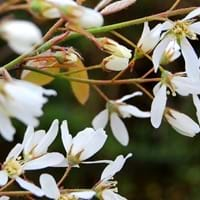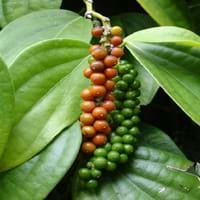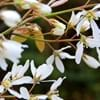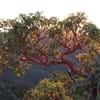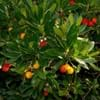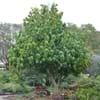Life Span
Perennial
Perennial
Type
Tree
Broadleaf Evergreen, Vines
Origin
United States, Northeastern United States, Mid-Atlantic United States, Southeastern United States, Central United States, South-Central United States
India, Indonesia, Southeast Asia, Southern Asia
Types
shadbush, wild plum
Red pepper, Orange pepper
Habitat
Swamps, Thickets, Woods
Moist Soils, orchards, Temperate Regions
USDA Hardiness Zone
4-9
8-15
Sunset Zone
2a, 2b, 3a, 3b, 4, 5, 6
H1, H2, 8, 9, 14, 15, 16, 17, 18, 19, 20, 21, 22, 23, 24
Habit
Oval or Rounded
Clump-Forming
Minimum Width
Not Available
Flower Color
White
Lemon yellow
Flower Color Modifier
Bicolor
Bicolor
Fruit Color
Red, Violet, Plum
Red, Green, Light Green
Leaf Color in Spring
Green, Gray Green
Light Green, Dark Green
Leaf Color in Summer
Green
Light Green
Leaf Color in Fall
Yellow, Red, Orange, Orange Red
Light Green, Dark Green
Leaf Color in Winter
Not Available
Light Green, Dark Green
Leaf Shape
Oval
Circular cordate
Plant Season
Spring, Summer, Fall
Spring, Summer, Fall, Winter
Sunlight
Full Sun, Partial Sun
Full Sun, Partial Sun, Partial shade
Type of Soil
Clay, Loam, Sand
Loam, Sand
The pH of Soil
Acidic, Neutral, Alkaline
Acidic, Neutral, Alkaline
Soil Drainage
Average
Average
Bloom Time
Spring
Not Available
Tolerances
Not Available
Drought
Where to Plant?
Ground
Container, Ground
How to Plant?
Grafting, Seedlings, Stem Planting
Seedlings, Stem Planting, Vegetative Reproduction
Plant Maintenance
Medium
Medium
Watering Requirements
occasional watering once established
Do Not over Water, Sprinkle water over foliage, Water every two or three days during warmer months
In Summer
Drought Tolerant
Lots of watering
In Spring
Moderate
Moderate
In Winter
Less Watering
Average Water
Soil pH
Acidic, Neutral, Alkaline
Acidic, Neutral, Alkaline
Soil Type
Clay, Loam, Sand
Loam, Sand
Soil Drainage Capacity
Average
Average
Sun Exposure
Full Sun, Partial Sun
Full Sun, Partial Sun, Partial shade
Pruning
No need to prune, Prune if you want to improve plant shape
A hard prune may be necessary if the plant becomes woody, Remove dead branches, Trim each shoot back to the first set of leaves
Fertilizers
All-Purpose Liquid Fertilizer, Less fertilizing
10-10-10 diluted liquid fertilizer, All-Purpose Liquid Fertilizer, Do not let fertilizers touch the leaves
Pests and Diseases
Bacterial leaf spot, Beetles, Powdery mildew, Red blotch, Rust
Aphids, Beetles, Root rot, Rust, Scab
Plant Tolerance
Drought, Heat And Humidity
Heat Tolerance, Humidity, Salt and Soil Compaction
Flowers
Showy
Not Available
Flower Petal Number
Single
Single
Foliage Texture
Medium
Medium
Foliage Sheen
Matte
Matte
Attracts
Birds, Deers, Hoverflies
Aphids, Leafminer, Snails, Squirrels
Allergy
no allergic reactions
Oral Allergy
Aesthetic Uses
Not Used For Aesthetic Purpose
Beautification, Cottage Garden, Decorating walls
Beauty Benefits
Improve skin condition, Not Available, Skin Problems
Acne, Blackheads
Environmental Uses
Agroforestry, Food for animals, Food for birds, No fertilizer, pesticides, or herbicides needed, soil stabilisation
Fixes Nitrogen, Insect Repellent
Medicinal Uses
Diarrhea, Gastrointestinal disorders, Menstrual Disorders
Acid Reflux, Dysentry, Healthy teeth, Inflammation, Oral health
Part of Plant Used
Fruits
Dried seeds
Other Uses
Food for animals, Used As Food
Culinary use, Oil is used for aromatherapy, Used in herbal medicines
Used As Indoor Plant
No
Yes
Used As Outdoor Plant
Yes
Yes
Garden Design
Edible, Feature Plant, Foundation, Fruit / Fruit Tree, Mixed Border, Screening / Wind Break, Shade Trees
Container, Feature Plant, Hedges, Screening / Wind Break, Tropical
Botanical Name
AMELANCHIER arborea
Piper nigrum
Common Name
Common Serviceberry, Downy Serviceberry, Juneberry, Shadbush
Peppercorn, Piper, Black pepper
In Hindi
Juneberry
काली मिर्च
In German
Felsenbirnen
Pfeffer
In French
Amélanchier
Piper nigrum
In Spanish
Amelanchier
Poivrier noir
In Greek
Juneberry
μαύρο πιπέρι
In Portuguese
Amelanchier
Pimenta-preta
In Polish
Świdośliwa
Pieprz czarny
In Latin
Amelanchier
nigrum piperis
Phylum
Magnoliophyta
Magnoliophyta
Class
Magnoliopsida
Magnoliopsida
Family
Rosaceae
Piperaceae
Clade
Dicotyledonous
Angiosperms, Monocots
Tribe
Not Available
Not Available
Subfamily
Malvoideae
Not Available
Number of Species
Not Available
Season and Care of Juneberry and Black pepper
Season and care of Juneberry and Black pepper is important to know. While considering everything about Juneberry and Black pepper Care, growing season is an essential factor. Juneberry season is Spring, Summer and Fall and Black pepper season is Spring, Summer and Fall. The type of soil for Juneberry is Clay, Loam, Sand and for Black pepper is Loam, Sand while the PH of soil for Juneberry is Acidic, Neutral, Alkaline and for Black pepper is Acidic, Neutral, Alkaline.
Juneberry and Black pepper Physical Information
Juneberry and Black pepper physical information is very important for comparison. Juneberry height is 610.00 cm and width 300.00 cm whereas Black pepper height is 180.00 cm and width Not Available. The color specification of Juneberry and Black pepper are as follows:
Juneberry flower color: White
Juneberry leaf color: Green and Gray Green
Black pepper flower color: Lemon yellow
- Black pepper leaf color: Light Green and Dark Green
Care of Juneberry and Black pepper
Care of Juneberry and Black pepper include pruning, fertilizers, watering etc. Juneberry pruning is done No need to prune and Prune if you want to improve plant shape and Black pepper pruning is done A hard prune may be necessary if the plant becomes woody, Remove dead branches and Trim each shoot back to the first set of leaves. In summer Juneberry needs Drought Tolerant and in winter, it needs Less Watering. Whereas, in summer Black pepper needs Lots of watering and in winter, it needs Average Water.
